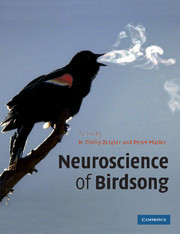Description
Neuroscience of Birdsong
Coordinators: Zeigler H. Philip , Marler Peter
A pioneering study identifying common brain mechanisms in both birds and humans.
Language: English
Subject for Neuroscience of Birdsong:
Publication date: 11-2012
Support: Print on demand
Support: Print on demand
Description
/li>Contents
/li>
Speech has long been thought of as a uniquely defining characteristic of humans. Yet song birds, like humans, communicate using learned signals (song, speech) that are acquired from their parents by a process of vocal imitation. Both song and speech begin as amorphous vocalizations (subsong, babble) that are gradually transformed into an individualized version of the parents' speech, including dialects. With contributions from both the founding forefathers and younger researchers of this field, this book provides a comprehensive summary of birdsong neurobiology, and identifies the common brain mechanisms underlying this achievement in both birds and humans. Written primarily for advanced graduates and researchers, there is an introductory overview covering song learning, the parallels between language and birdsong and the relationship between the brains of birds and mammals; subsequent sections deal with producing, processing, learning and recognizing song, as well as with hormonal and genomic mechanisms.
Part I. Foundations: Singing and the Brain: 1. Introduction H. P. Zeigler; 2. Birdsong and human speech Alison Doupe and Pat Kuhl; 3. Birdsong and singing behavior Heather Williams; 4. The Australian Magpie (Gymnorhina tibicen): an alternative model for the study of songbird neurobiology Gisela Kaplan; 5. Songbirds and the revised avian brain nomenclature Anton Reiner, David J. Perkel, Claudio V. Mello and Erich D. Jarvis; 6. The songbird brain in comparative perspective Michael Farries and David. J. Perkel; Part II. Song Production and its Neural Control: 7. Introduction H. P. Zeigler; 8. Mechanisms of song production in songbirds Roderick A. Suthers and Sue Ann Zollinger; 9. Peripheral sensorimotor mechanisms and the control of song Franz Goller and Brenton G. Cooper; 10. Integrating breathing and singing: forebrain and brainstem mechanisms Marc F. Schmidt and Robin Ashmore; 11. Birdsong: anatomical foundations and central mechanisms of sensorimotor integration J. Martin Wild; Part III. Hearing and Recognizing the Song: 12. Introduction Peter Marler; 13. Song selectivity and the songbird brain Frédéric E. Theunissen, Noopur Amin, Sarita Shaevitz, Sarah M. N. Woolley, Thane Fremouw and Mark E. Hauber; 14. Song-selective neurons: synaptic mechanisms and functional roles J. F. Prather and Richard Mooney; 15. Temporal auditory pattern recognition in songbirds Tim Gentner; Part IV. Learning the Song: Mechanisms of Acquisition and Maintenance: 16. Introduction Peter Marler; 17. Comparative aspects of song learning Henrike Hultsch and Dietmar Todt; 18. Developmental song learning in the zebra finch Sigal Saar, Partha P. Mithra, Sebastien Deregnaucourt and Ofer Tchernichovski; 19. Auditory feedback and singing in adult birds Sarah M. N. Woolley; 20. The anterior forebrain pathway and vocal plasticity Michael S. Brainard; 21. Circuits and cellular mechanisms of sensory acquisition Kathy and Ernest Nordeen; 22. Chasin' the trace: the neural substrate of birdsong memory Johan J. Bolhuis; 23. The template concept - crafting a song replica from memory Patrice Adret; Part V. Mechanisms of Modulation and Plasticity: 24. Introduction Peter Marler; 25. Hormonal modulation of singing behavior: methodology and principles of hormone action Cheryl F. Harding; 26. Sex differences in brain and behavior and neuroendocrine control of the motivation to sing Gregory F. Ball, Lauren V. Riters, Scott A. MacDougall-Shackleton and J. Balthazart; 27. Plasticity of the song control system in adult birds Eliot Brenowitz; 28. Regulation and function of neuronal replacement in the avian song system Carolyn Pytte, Linda Wilbrecht and John R. Kirn; Part VI. The Genomic Revolution and Birdsong Neurobiology: 29. Introduction H. P. Zeigler; 30. Studies of songbirds in the age of genetics: what to expect from genomic approaches in the next 20 years David F. Clayton and Arthur P. Arnold; 31. Behavior-dependent expression of inducible genes in vocal learning birds Claudio V. Mello and Erich D. Jarvis; 32. Genes for tuning up the vocal brain: FoxP2 in human speech and birdsong Sebastian Haesler and Constance Scharff; Part VII. On a Personal Note: 33. Introduction H. P. Zeigler; 34. William Homans Thorpe: a biographical memoir R. A. Hinde; 35. My journey with birdsong M. Konishi; 36. The discovery of replaceable neurons Fernando Nottebohm; 37. The birdsong saga Peter Marler; Part VIII. Collected References.
© 2024 LAVOISIER S.A.S.




